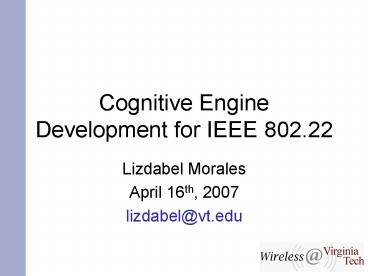Cognitive Engine Development for IEEE 802.22 PowerPoint PPT Presentation
1 / 14
Title: Cognitive Engine Development for IEEE 802.22
1
Cognitive Engine Development for IEEE 802.22
- Lizdabel Morales
- April 16th, 2007
- lizdabel_at_vt.edu
2
Presentation Outline
- Introduction
- IEEE 802.22
- Cognitive Radio
- CE Development Approach
- Simulation and Results
- Future Work
3
What is a cognitive radio?
Cognitive radio
Cognition cycle
- An enhancement on the traditional software radio
concept wherein the radio is aware of its
environment and its capabilities, is able to
independently alter its physical layer behavior,
and is capable of following complex adaptation
strategies.
4
Cognitive Radio is a promising tool for
- Access to spectrum
- finding an open frequency and using it
- Interoperability
- talking to legacy radios using a variety of
incompatible waveforms
5
Motivation for using cognition in IEEE 802.22
Systems
- Using previous experience to predict
- Channel reputation
- Incumbent detection
- Other patterns
- Protect incumbent users by being aware of the
environment - Co-existence and self co-existence
- Spectrum utilization improvements
- Future proofing for other CR technologies
It is not known whether a CR network can offer
satisfactory performance despite the injection of
many new incumbent handling mechanisms
Cordeiro, et. al. 2005
6
MPRGs Development of an IEEE 802.22 Cognitive
Engine
- Objective was to create a Cognitive Engine for
IEEE 802.22 systems - Phases I and II completed
- Main Accomplishments
- Development of a solid and generic architecture
for the IEEE 802.22 CE - Development of a flexible framework that allows
for future design, development and testing of
more sophisticated modules
7
WRAN Considered Scenario
- System Description
- Single WRAN BS
- CPEs with different application requests
- Incumbent users TV only and Part 74 devices
- Events that trigger change in the system
- New CPE service request in the WRAN
- Incumbent detected in TV channel
8
Cognitive Engine Architecture
9
Cognitive Engine Modules
- Sensing Module provides radio environment
sensing results - REM provides a snapshot of the radio scenario
through time - Main Controller decides which algorithm to use
- Case and Knowledge Reasoner provides coarse
solution, starting point for the Multi-objective
Optimizer - Multi-objective Optimizer further refines the
solution obtained by the CBR
10
Utility function Performance metrics
- Utility function used in CE should reflect the
performance metrics of cognitive WRAN systems,
and weight of each performance metrics may vary
with radio scenarios - U1 QoS satisfaction of each (uplink and
downlink) connection for adding new CPE
connections - U2 Incumbent PU protection (fast adaptation and
evacuation) more important for relocating CPEs
in case PU reappears - U3 Spectral efficiency more important for
multi-cell or large number of CPEs - U4 Power efficiency and interference
temperature reduction more important for mobile
UE and large-scale cognitive networks
U w1U1 w2U2 w3U3 w4U4
11
Testing scenarios for WRAN BS CE Performance
evaluation
12
REM-CKL vs. GA
CKL runs much faster than GA, especially under
complicated situations.
13
802.22 Specification
Current framework picks up after incumbent user
is detected
14
Questions

